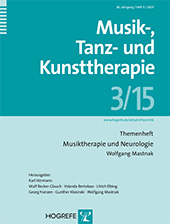Music Therapy for Epilepsy
Abstract
Abstract. Researchers are increasingly looking toward nondrug therapeutic interventions in controlling seizures in epilepsy. Music therapy has shown potential therapeutic benefit in cognitive science. Here we focus on the evidence base for its utility as a therapy in epilepsy.
Zusammenfassung. Forscher lenken ihren Blick zunehmend auf nicht-medikamentöse Interventionen, um epileptische Anfälle zu kontrollieren. Musiktherapie hat sich im Bereich kognitiver Wissenschaften als potentiell hilfreiches Therapeutikum erwiesen. Hier konzentrieren wir uns auf den evidenzbasierten Nutzen von Musiktherapie bei Epilepsie.
References
(1990). Anticonvulsant action of SCH 23390 in the striatum of the rat. European Journal of Pharmacology, 191, 329 – 336.
(2009). Phase dependent stimulation effects on bursting activity in a neural network cortical simulation. Epilepsy Research, 84(1), 42 – 55.
(2005). Long-term enhancement of maze learning in mice via a generalized Mozart effect. Neurological Research, 27, 791 – 796.
(2010). Revised terminology and concepts for organization of seizures and epilepsies: Report of the ILAE Commission on Classification and Terminology, 2005 – 2009. Epilepsia, 51, 676 – 685.
(2012). Reduction of seizure occurrence from exposure to auditory stimulation in individuals with neurological handicaps: A randomized controlled trial. PLoS ONE, 7(10), e45303.
(1998). The “Mozart effect” on epileptiform activity. Clinical Electroencephalography and Neuroscience, 29, 109 – 119.
(1991). Psychological stress increases dopamine turnover selectively in mesoprefrontal dopamine neurons of rats: Reversal by diazepam. Brain Research, 557, 154 – 161.
(2010). Effect of music on the recovery of a patient with refractory non-convulsive status epilepticus. Epilepsy & Behavior, 18, 491 – 493.
(2007). The Mozart effect: Encore. Epilepsy & Behavior, 11, 152 – 153.
(2011). Mozart K.448 acts as a potential add-on therapy in children with refractory epilepsy. Epilepsy & Behavior, 20, 490 – 493.
(2012). Mozart k.545 mimics Mozart k.448 in reducing epileptiform discharges in epileptic children. Evidence-Based Complementary and Alternative Medicine, 607517.
(2010). Mozart K.448 and epileptiform discharges: Effect of ratio of lower to higher harmonics. Epilepsy Research, 89, 238 – 245.
(2009). Seizure propagation in a patient with musicogenic epilepsy. Epilepsy & Behavior, 14, 421 – 424.
(2006). Music and mirror neurons: From motion to ‘e’motion. Social Cognitive and Affective Neuroscience, 1, 235 – 241.
(2008). Videopolygraphic and functional MRI study of musicogenic epilepsy. A case report and literature review. Epilepsy & Behavior, 13, 685 – 692.
(1998). Improved maze learning through early music exposure in rats. Neurological Research, 20, 427 – 432.
(1993). Music and spatial task performance. Nature, 365, 611.
(1996). The role of dopamine in epilepsy. Synapse, 22, 159 – 194.
(2006). Music and the brain: Disorders of musical listening. Brain, 129, 2533 – 2553.
(2004). The acute effect of music on interictal epileptiform discharges. Epilepsy & Behavior, 5, 662 – 668.


